| |
|
SECTION X: CHAPTER 1
METRIC SYSTEM CONVERSION
Contents:
| I. II. III. IV. |
Introduction The Metric System Conversion References |
- INTRODUCTION.
- Use of metric measurement standards in the United States has been authorized by law since 1866. In 1988, Congress enacted legislation (Public
Law 00-418) to establish the metric system as the preferred system of weights and measures for all domestic trade and commerce. This legislation also required the use of metric measurement standards in all Federal activities. On July 25, 1991, the President issued Executive Order 12770, which reiterated the order to implement the metric system "as the preferred system of weights and measures for United States trade and commerce." This executive order directed all Federal agencies to implement "metrification" to the extent economically feasible by September 30, 1992.
- In 1988, when Congress enacted metrification legislation, the U.S. was the only major industrial nation not using the metric system. As a result, domestic industries were often at a competitive disadvantage and were sometimes
even excluded from the international marketplace. In its deliberations, Congress also found that the inherent simplicity of the metric system could lead to major cost savings, further enhance our international competitive
position, and provide substantial advantage to the Federal Government in its own operations. Commercially, metric measure is sometimes used as a household measure in the U.S., e.g.
two-liter soft drinks. Most food labels list both metric and English measure. Metric measure labeling has opened markets for business products in areas which use metric measure daily.
- OSHAs safety compliance operations and industrial hygiene efforts have an advantage in metrification because the biological, chemical, and physical sciences have long used the metric system. Students of these subjects have
been using metric weights and measures along with daily use of the "English" system of measures for decades. Time-weighted averages (TWA), permissible exposure limits (PEL), and sampling and reporting forms all make use
of the metric system. For example, the industrial hygiene Air Sampling Report,
OSHA-91(S) (Rev. 1/84) requires data as metric measures and weights. Also examine OSHA reference TableZ-1-A (29 CFR 1910 Subpart Z).
- Use of metric measurement standards in the United States has been authorized by law since 1866. In 1988, Congress enacted legislation (Public
- THE METRIC SYSTEM.
- BASE UNITS.
- Originally, there were only two basic reference points, the meter for length and the gram for weight. The list of reference points has been expanded for the International System (SI) to include
the kilogram (instead of the gram) for mass, the second for time, the ampere for electric current, the degree Kelvin for temperature, and the candela
for light intensity (see Table
X:1-1).
- The reference objects for these International standards units are maintained for comparisons and checked periodically against other international references by the National Institute for Standards and Technology (NIST).
The base units used in the metric system are given in Table
X:1-1 below.
TABLE X:1-1. METRIC BASE UNITS Unit
MeasurementUnit
namesymbol
Length meter m Mass kilogram kg Time second s Electric current ampere A Thermodynamic
temperatureKelvin K Amount of substance mole mol Luminous intensity candela cd
- Originally, there were only two basic reference points, the meter for length and the gram for weight. The list of reference points has been expanded for the International System (SI) to include
the kilogram (instead of the gram) for mass, the second for time, the ampere for electric current, the degree Kelvin for temperature, and the candela
for light intensity (see Table
- POWERS OF TEN.
- The metric system entails the use of multiples or powers of ten to describe magnitudes greater or less than the basic units of meter, gram, ampere, and so forth. The prefixes for the multiples and submultiples
of basic units are presented in Table
X:1-2. For example, mass or weight can be presented as:
- the kilogram is 1000 grams; and
- the milligram is 1/1000 gram.
In addition, there are:
- 100 centimeters to one meter; and
- 1000 meters to one kilometer.
Also, volume can be presented as:
- 10 deciliters in one liter;
- 10 liters in one decaliter; and
- 10 decaliters in one hectoliter.
TABLE X:1-2. PREFIXES AND SYMBOLS FOR DECIMAL MULTIPLES AND SUBMULTIPLES OF UNITS1 Power of 10 Prefix Symbol
1012 tera T 109 giga G 106 mega M 103 kilo k 102 hecto h 101 deca* da 10-1 deci d 10-2 centi c 10-3 milli m 10-6 micro m 10-9 nano n 10-12 pico p 10-15 femto f 10-18 atto a * Also "deka."
1 Conférence générale des Poid et Mesures, Comtes rendus de séances de la 11e Conférence générale des Poids et Mesures, Paris 1960,Gauthier-Villars, Paris 1961, page 87; Conférence générale des Poids et Mesures, Comtes rendus des séances de la 12e Conférence générale des Poids et Mesures, Paris 1964,Gauthier-Villars, Paris, 1964, page 94. -
Area and volume in both inch-pound and the metric system are calculated similarly. Area is length times width with the measure of each side in the same units for both length and width for square feet (feet2)
or square meters (m2). Volume is likewise length times width times height: cubic yards (yard3) or cubic meters (m3).
The metric measure of a liter is defined as a volume of 1000 cubic centimeters (cc) or a volume of 10 cm by 10 cm by 10 cm.
- In physics, some measurements are defined by several metric units. These derived units are named, generally, for the scientists who first defined the measurement. The metric expression as a combination of metric units is presented in Table X:1-3 below.
- The metric system entails the use of multiples or powers of ten to describe magnitudes greater or less than the basic units of meter, gram, ampere, and so forth. The prefixes for the multiples and submultiples
of basic units are presented in Table
TABLE X:1-3. DERIVED SI UNITS WITH SPECIAL NAMES Unit
nameSymbol Formula Expressions as
metric base unitsFrequency hertz Hz 1/s or s-1 s-1 Force newton N m • kg • s-2 m • kg • s-2 Energy, Work joule J N • m m2 • kg • s-2 Power watt W J/s m2 • kg • s-3 Electric charge coulomb C A • s A • s Electric potential volt V W/A m2 • kg • s-3 • A-1 Electric resistance ohm W V/A m2 • kg • s-3 • A-2 Electric capacitance farad F C/V m-2 • kg-1 • s4 • A2 Magnetic flux weber Wb V • s m2 • kg • s-2 • A-1 Pressure, Stress pascal Pa N/m2 m-1 • kg • s-2 Conductance siemens S A/V m-2 • kg-1 • s3 • A2 Magnetic flux density tesla T Wb/m2 kg • s-2 • A-1 Inductance henry H Wb/A m2 • kg • s-2 • A-2 Luminous flux lumen lm cd • sr cd • sr Illuminance lux lx lm/m2 m-2 • cd • sr
- BASE UNITS.
- CONVERSION.
- THE CONVERSION PROCESS.
- The conversion equivalent for an inch is 1 inch equals 2.54 centimeters or 25.4 millimeters. The measure and units to be converted are multiplied by the conversion factor to yield the new measure and units. Do include
the units in the conversion calculation and cancel the units as part of the calculation process (Table X:1-4).
- Each conversion factor has the metric units per inch-pound units and should be included in the calculation converting inch-pound units to metric units until the use of the conversion factor is ingrained in the user.
During a calculation, like units divided by like units equal one and cancel themselves, as shown in Table X:1-4 below.
- Because of the number of conversion factors presented in Federal Standard 376A (May 5, 1983), include with the numeric conversion factor both metric and inch-pound unit labels during the calculations. Cancel like units during the calculation. Then only the new measurement unit labels will remain (see Table X:1-4).
TABLE X:1-4. AN EXAMPLE OF AN INCH-POUND TO SI METRIC CONVERSION Original inch-pound
measureConversion Calculated
metric measure1 inch 2.54 cm/inch
1 inch • 2.54 cm/inch
1 inch • 2.54 cm/inch2.54 cm
(Or 25.4 mm) - The conversion equivalent for an inch is 1 inch equals 2.54 centimeters or 25.4 millimeters. The measure and units to be converted are multiplied by the conversion factor to yield the new measure and units. Do include
the units in the conversion calculation and cancel the units as part of the calculation process (Table X:1-4).
- CONVERSION PRECISION.
- Some conversion factors have been developed to seven significant digits, e.g. Federal Standard 376A includes the conversion factor for the foot (survey) as used in the United States as:
1 ft (survey) = 0.3048006 m
- When using a conversion factor, round resulting calculations to the number of significant digits of the original
inch-pound measurement or to fewer significant decimal positions.
- Precision is not increased by converting from
inch-pound to metric by amultiple-digit conversion factor.
- Calculations or conversion of a measurement from
inch-pound to metric measure requires the application of three rules of calculation, often done by habit.
-
Significant number of digits. A distance shown as 61 miles has two significant digits, implying measurement accuracy to a whole number of miles. A distance written as 61.6 miles is three significant
digits, two plus one decimal digit and implies accuracy to one-tenth of a mile. The number of digits presented usually reflects the accuracy of the actual measurement. The figures in 61 miles or 61.2 miles
may represent an automobiles odometer measurement. A surveyors measurement may be represented as 61.243 miles from measurement stake point to stake point: five significant digits including three decimals.
- Number of carried digits.
- If the conversion number will result in a larger number, 1.609 km/mi, carry only the total number of first number digits, e.g.:
- 61 mi × 1.609 km/mi calculates to 98.149 km but is presented as 98 km.
- 61.2 mi × 1.609 km/mi calculates to 98.4708 km but is presented as 98.5 km.
- 61.243 mi × 1.609 km/mi calculates to 98.539987 km but is presented as 98.540 km.
- If the conversion number will result in a smaller number, carry only the total number of first number digits plus one extra digit, e.g.:
- 4 lb × 0.453 lb/kg calculates to 1.812 kg but is presented as 1.8 kg (for measurement by a household scale).
- 4.3 lb × 0.453 lb/kg calculates to 1.9479 kg but is rounded up and is presented as 1.95 kg (for measurement by a postal scale).
- 4.33 lb × 0.453 lb/kg calculates to 1.96149 kg is presented with no rounding as 1.961 kg (for measurement by a laboratory scale).
- If the conversion number will result in a larger number, 1.609 km/mi, carry only the total number of first number digits, e.g.:
- "Rounding" of numbers. To "round off" calculated numbers to a minimum number of significant digits, follow these rules:
- When a number such as 13.34 is to be rounded to 13.3+, the digit 4 is less than 5 so the number is rounded to an unchanged 13.3.
- When a number as 13.37 is to be rounded to 13.3+, the digit 7 is equal to or greater than 5 so the number is rounded or increased to a changed 13.4.
- When a number such as 13.34 is to be rounded to 13.3+, the digit 4 is less than 5 so the number is rounded to an unchanged 13.3.
- CONVERSION EQUIVALENTS.
- The document to be used as a primary reference for
inch-pound to metric conversions is Federal Standard 376A, Preferred Metric Units for General Use by the Federal Government, May 5, 1983. A selected number of conversion factors are presented in TablesX:1-5 throughX:1-15 below.
-
The basic units of the measurement system are by definition to man-made reference standards for mass or weight (the kilogram) and length (the meter). Some units of measure are mathematically derived, as plane and solid
angle measures (from geometry), or derived from astronomical phenomena, time, or are not related to either mass or length measurement references. The units for these measures have not changed. A measure of frequency,
cycles per second (cps), has been renamed Hertz to honor the German physicist H. R. Hertz.
-
Measures of light were defined in physics originally in terms of the metric system and have not changed. If the measure of light was converted to the
inch-pound system, and includesinch-pound area measures as part of its definition, a conversion to metric equivalents is necessary. These exceptions to light measurements are presented in the appropriate table.
-
Metrification or establishment of the measure system as a base of ten is extended to temperature measures.
- G.D. Fahrenheit, the German physicist, defined a scale of measure for his alcohol thermometer in 1709 and used the same scale again in 1714 for his mercury thermometer. On this scale, water freezes at 32° and
boils at 212°. The base of ten temperature scale definition of Anders Celsius, the Swedish astronomer, is used in the metric system for temperature measures. The point at which water freezes or becomes a solid
is 0° Celsius and the point of transition of water from a liquid to a gas is at 100° Celsius.
[These definitions assume that the atmospheric pressure is at a standard of 760 mm of mercury pressure.]
-
The relationship between the arbitrary Fahrenheit scale and the Celsius scale used within the metric system is:

- G.D. Fahrenheit, the German physicist, defined a scale of measure for his alcohol thermometer in 1709 and used the same scale again in 1714 for his mercury thermometer. On this scale, water freezes at 32° and
boils at 212°. The base of ten temperature scale definition of Anders Celsius, the Swedish astronomer, is used in the metric system for temperature measures. The point at which water freezes or becomes a solid
is 0° Celsius and the point of transition of water from a liquid to a gas is at 100° Celsius.
- The document to be used as a primary reference for
TABLE X:1-5. LENGTH 
The equation must be applied for the conversion. For everynine-degree interval on the Fahrenheit temperature scale (°F), the Celsius temperature scale (°C) changes only five units. Please note that at the freezing point for water, the Celsius scale is at zero but the Fahrenheit scale is at 32°. It is convenient to remember that only at-40° are both scales equivalent, or :-40°C = -40°FTABLE X:1-6. AREA 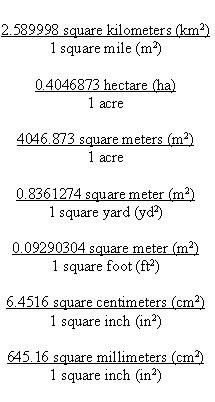
TABLE X:1-7. VELOCITY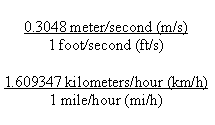
TABLE X:1-8. VOLUME
TABLE X:1-9. MASS WEIGHT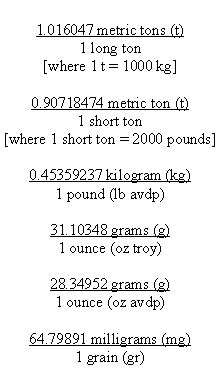
TABLE X:1-10. DENSITY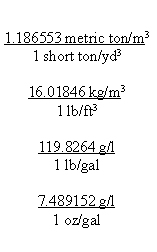
TABLE X:1-11. PRESSURE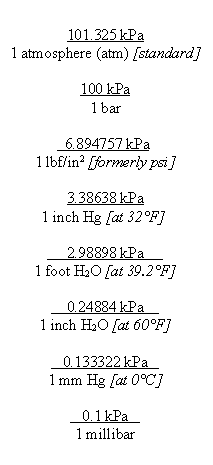
TABLE X:1-12. STRESS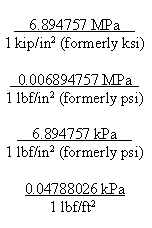
TABLE X:1-13. WORK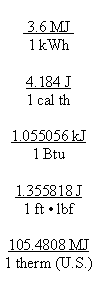
TABLE X:1-15. MISCELLANEOUS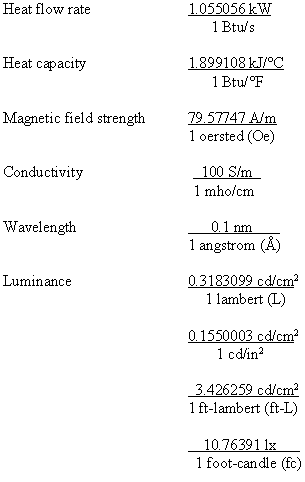
TABLE X:1-14. POWER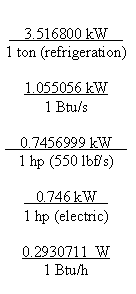
- REFERENCES.
General Services Administration. Federal Standard 376A, Preferred Metric Units for General Use by the Federal Government, May 5, 1983.
- Some conversion factors have been developed to seven significant digits, e.g. Federal Standard 376A includes the conversion factor for the foot (survey) as used in the United States as:
- THE CONVERSION PROCESS.
